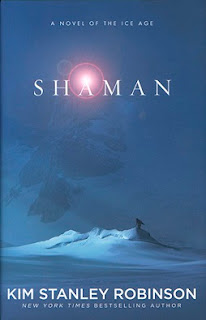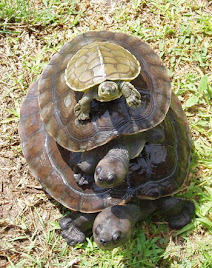Shaman (Kim Stanley Robinson)
Shaman
Spoiler level: Moderate
Shaman (Kim Stanley Robinson; 2013) is set early in human history — back when we were still coexisting with Neanderthals or some other early humanoid life forms (which adds an interesting component to the book). The main character — Loon — is a shaman-in-training. We open at the start of his walkabout trial, which makes up a relatively small portion of the book and introduces the reader to Loon's skillsets and ways of life. During the walkabout, Loon longs for the comforts of home and then, once it is over, longs for the freedom of the walkabout — the freedom of being away from his responsibilities in the pack. This pervasive and eternal "the grass is always greener" mindset is one of the many examples of how Loon's life is relatable to modern humans (i.e. the readers). And yet, Loon also arguably has a greater appreciation for what he does have than the average reader (at least this reader) — a perspective that left me with feel-good vibes after finishing the book. This made it, in retrospect, a great New Year's pick.
The first part of the book leisurely progresses through Loon's late adolescence. He is learning different skills, like how to make cave paints, and reflecting on life in his little pack of humans. The reader is right alongside him for the ride. Admittedly, I wondered a little where the book was going during this first half, but overall I enjoyed it. It's a nice window into how the author has imagined life at this time to be, and seems to be based on a lot of underlying research on his part as well. I especially appreciated how spring, not winter, is described as the most difficult time of year for the pack of humans. As a wildlife biologist who lives at and studies animals at higher latitudes (the northern U.S.), the common misconception I encounter is that winter is the hardest time of year for animals. Actually, spring is usually the hardest time of year, including the early humans in Shaman. As detailed in the book, this is because stored food and fat reserves are running low at the end of the winter, and also it takes a while in spring for new food sources (like seasonal migrant animals to return or food plants) to become available.
In the later portion of the book, the plot solidifies. I found myself binging the second half in one prolonged marathon (listening to the audiobook during a long drive home from the holidays, and continuing the next day as I unpacked and did chores). Loon is suddenly facing big challenges. He gets married, only to have his wife kidnapped by another pack of humans. When he tries to rescue her, he gets kidnapped himself, and lives as a slave to this more northern pack of humans for a time. A rescue is attempted by Thorn (the Shaman in his tribe who he is apprenticed under) and Click (one of the "old ones", which are a race of non-human hominids). Their attempted escape is one of endurance and ingenuity as they try to survive the elements and their pursuers.
Ultimately, I loved this book because it was simultaneously relatable & refreshing. Relatable because Shaman makes it clear that there are shared fundamentals to the human experience, whether it be 2023 or 25,000 BCE. Adolescence means simultaneously learning the ways the world works while questioning it. Eventually we enter into adulthood, one half-step at a time, becoming part of the established ways while also not being fully sold on them. We see this in how Loon starts to fill out his role in the pack with age, as well as in Heather, a critical yet blasé old woman who is one of Loon's mentors, and provides additional counter perspectives. Loon attempts to balance his love of the simple things — spending time with his wife and children (or, earlier in the book, just himself) with the the expectations of society — in this case becoming his pack's next shaman. Loon is a somewhat begrudging in this, but also recognizes the importance of the role. Thorn won't have time to train another apprentice before his death, and the pack needs a shaman.
The refreshing part is of the book is that Loon isn't plagued by a pervasive sense of anxiety that seems to face so many now, despite having to contend with substantial uncertainties regarding his survival. He either accepts things (more or less) or tries to change them. As a youth he lusts after Sage, a beautiful woman from his pack, but gives her up relatively easily once the situation changes. He is training to fill some pretty big shoes (those of Thorn, the shaman he is replacing) in a uniquely important role. Although he doesn't seem particularly well-suited for the position in some ways, he also isn't too worried about it. There is growing conflict within the pack, and when Loon is old enough he helps initiate a partial split that gives different factions their space while also maintaining connectivity for purposes of survival. In some situations "The Old Ones" are dangerous enemies, and in other situations they can be allies. It simply depends, and you have to feel life out as you go along.
It sounds trite and a little silly, but Loon isn't preoccupied with social media, achieving notoriety, or anything too far outside of his immediate survival and surroundings. Instead, he is imbued with a certain necessary practicality. Next spring may or may not be a hard one, but there's no sense in worrying about it now, beyond making the necessary preparations. It will either be a good spring or a bad spring.
Loon thinks everything is good in its way, all women are beautiful in their unique ways, and it's something to be thankful for when an animal dies and you get to eat it. In this way he embodies the mindfulness mentality sought by many in modern society.
As a final note, I appreciated the author's treatment homosexuality and women's rights. In Shaman, homosexuality doesn't get more than a bat of an eye, and women are certainly equal to men. On average, women aren't as strong and have different roles in society, but there are no hard rules in Shaman, just like in modern life. Loon's wife is larger and stronger than most people, even saving Loon by carrying him for part of their escape from the kidnapper tribe. Rape is effectively punishable by death because the women can simply decide to slip something into your food if they, collectively, decide. These treatments are no surprise from Kim Stanley Robinson, who normally writes in the overall progressive field of sci-fi. But it is especially appreciated in the context of fiction on early human history, a period in which topics like homosexuality and women's rights are often hijacked by those arguing that such things are modern apparitions (another pet peeve of mine as a professional biologist).
The truth is we don't entirely know how these things were viewed in past societies, and indeed different societies certainly had different takes, just as they do now. This point is highlighted well in Shaman. Stories are just stories — malleable and useful to a point. We pass them on and can put our own twist on them. This is at first to Loon's delight, as he cheekily modifies stories taught to him by his mentor, although later it's to his chagrin, when his child reverses his changes. Substituting stories as facts to prove a point about how we should be act now as a society is dumb and wrong (morally & factually), and yet stories can be powerful examples of the values we could hold, and in this sense, Shaman was a story I liked. Shaman was an introspective, exciting, and peaceful story about how we might have lived in the past, in a time when we were all more accountable to each other and didn't have to look too far beyond our own pack.
-GiGi
Format: audiobook read by Graeme Malcolm, borrowed from the library (thanks Libby)



Comments
Post a Comment